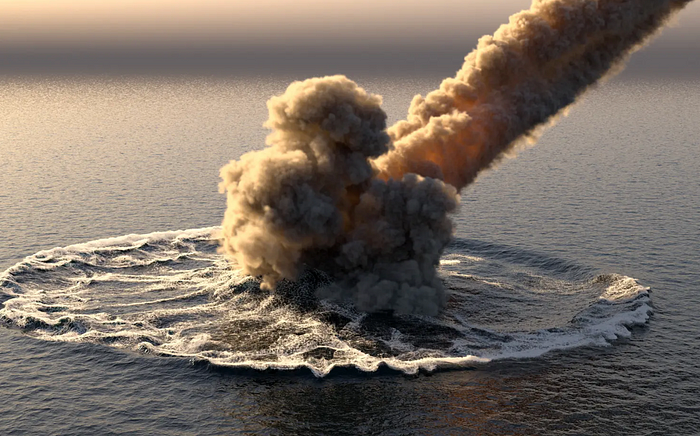The Pleasure of Figuring Out the Location of the First Interstellar Meteor

On January 8, 2014, an object from interstellar space collided with Earth at a speed of 45 kilometers per second, traversing within a second a distance that cars usually take an hour to cross.
As a result of its friction with air, the object disintegrated into tiny fragments tens of kilometers above the Pacific Ocean. As the surface area grew by fragmentation, more heat was released, generating a runaway process that created a fireball. The explosion released a few percent of the energy associated with the Hiroshima atomic bomb. The bright flare was detected by US Government (USG) cameras. The location was listed in the CNEOS fireball catalog to one significant digit after the decimal point in longitude and latitude.
In 2019, I wrote a paper with my student, Amir Siraj, that identified this object as the first interstellar meteor ever discovered. The interstellar origin was confirmed at the 99.999% confidence level in an official letter from the US Space Command to NASA. Together with the confirmation letter, the USG released the light curve of the fireball which showed three distinct explosions separated apart by a tenth of a second. This fireball data allowed us to conclude in a follow-up paper that the meteor was tougher than all other 272 meteors in the CNEOS catalog. Intrigued by this conclusion, we are now planning an expedition to scoop the meteor fragments from the ocean floor and analyze their composition, in order to determine whether the object is natural or artificial in origin. We have assembled a team of experts, designed the required machinery to retrieve the meteor fragments, found a suitable boat and received full funding for a ten-day expedition.
The only problem is that the published USG coordinates define the fireball location to within a 10-kilometer region, too large for an efficient search during a ten-day expedition. In recent months we had asked USG officials to provide us with better a localization of the meteor event. An additional significant digit could save us a factor of a hundred in search time. But despite our hopes, we received no additional information as of yet. Since the expedition date is only months away, we decided to check for any publicly available data from seismometers in the region.
To our delight, we found that the blast wave from the meteor explosion generated a high-quality signal in a seismometer located at Manus Island in Papua New Guinea, about a hundred kilometers away from the meteor explosion site. The sound signal includes two broad peaks separated by about a minute, each lasting for tens of seconds. At face value, this signal structure is surprising since the explosion lasted less than a second. How did the sound signal obtain this extended temporal shape?
On an early morning last week, I had the eureka moment which led to a sketch on how to derive a precise location of the explosion. Before my morning jog at sunrise, I sent Amir the sketch.
The interpretation of the sound signal is straightforward in retrospect. Within less than a kilometer from the explosion, the initial shock wave weakens to a sound signal. The sound continues to propagate through air, water and ground. The speed of sound in air is the slowest by an order of magnitude, being only a third of a kilometer per second. The different paths through the different media, allow independent geometric constraints from the corresponding components of the seismometer signal.
The first peak begins with a sound path that goes through air straight down to the ocean surface and then through water or the ground to the seismometer. The shortest path through air goes directly from the explosion to the seismometer and defines the beginning of the second peak in the Manus seismometer signal. The envelope of that second peak involves the sum over paths where the spherical blast wave in air reflects off the ocean surface in circles of different radii at different times, and with an amplitude that declines inversely with distance from each reflection point.
By using a simple geometry of a spherical blast wave bouncing off the ocean surface, we were able to reproduce the timing of the first peak and the shape of the second peak. Echoes from the three sub-explosions can also be identified as three triggers of the second peak in the sound signal.
Altogether, a simple geometric model for the propagation of sound waves from the explosion provides many more constraints than free parameters and allows to determine the explosion elevation and distance as well as the precise sound speed in air at that location.
Having more constraints than free parameters allows us to verify the validity of the interpretation and tighten the localization error bar. We ended up constraining the meteor path to a narrow arc within the original USG error box. This narrows down the search area by more than an order of magnitude, improving considerably the prospects for success in the forthcoming expedition.
As Richard Feynman noted, there is a pleasure of finding things out. In the context of localizing the first interstellar meteor, this pleasure is accompanied by the practical benefit of accomplishing the expedition goal. There is nothing more thrilling than finding an explanation to data that fits an over-constrained model. This discovery will guide our treasure hunt for interstellar fragments at the bottom of the Pacific Ocean.
Creative thinking can relieve the anxiety of waiting for the declassification of USG data, which at times feels like “Waiting for Godot” in Samuel Beckett’s play. Here’s hoping that we will indeed visit the meteor site within a few months and retrieve interstellar fragments. I can hardly wait to figure out their origin.
ABOUT THE AUTHOR

Avi Loeb is the head of the Galileo Project, founding director of Harvard University’s — Black Hole Initiative, director of the Institute for Theory and Computation at the Harvard-Smithsonian Center for Astrophysics, and the former chair of the astronomy department at Harvard University (2011–2020). He chairs the advisory board for the Breakthrough Starshot project, and is a former member of the President’s Council of Advisors on Science and Technology and a former chair of the Board on Physics and Astronomy of the National Academies. He is the bestselling author of “Extraterrestrial: The First Sign of Intelligent Life Beyond Earth” and a co-author of the textbook “Life in the Cosmos”, both published in 2021. His new book, titled “Interstellar”, is scheduled for publication in August 2023.
